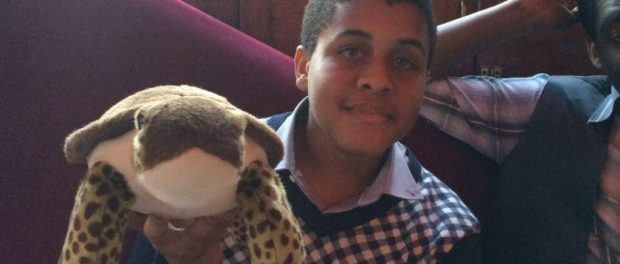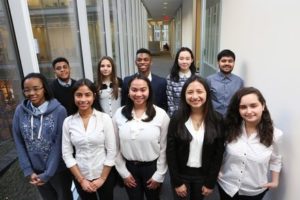St.Kitts Wiz Kid among The New York Times Scholarship Winners
Get our headlines on WHATSAPP: 1) Save +1 (869) 665-9125 to your contact list. 2) Send a WhatsApp message to that number so we can add you 3) Send your news, photos/videos to times.caribbean@gmail.com
 Aaron Jackson
Aaron Jackson

The winners of The New York Times scholarship are, front row, from left, Cynthia Pierre, Solangy Juarez, Sabrina Salas, Daisy Torres and Gabrielle Guz. Back row, from left, Aaron Jackson, Brianna Robeck, Jahmire Cassanova, Zhixing Che and Bilal Choudhry.
Basseterre, St. Kitts, March 11, 2018 – A national of St. Kitts and Nevis is among the New York Times Scholarship Winners Excelled Through Adversity programme.
Seventeen-year-old Kittitian, Aaron Jackson is among 10 students who have endured plenty of hardship, facing down the deaths of family members, poverty, displacement, abuse and other adversities that have forced each to grow up far too swiftly. And still they have achieved, academically, in the arts and as activists. Aaron grew up in the Village of Tabernacle , St.Kitts. The village is also the hometown and current residence of the country’s Prime Minister Dr. Hon Timothy Harris who himself grew up under similar tough conditions and is now the leader of the Caribbean’s fastest growing and most progressive countries.
The scholarship winners will work in various departments at The Times, including marketing, technology and the newsroom, and each will be given a laptop computer.
Sarah Maslin Nir in her story wrote Jackson is now a computer whiz, dabbling in website design, anime and video editing.
“When he moved to America as a teenager, he went to the Manhattan Center for Science and Mathematics, a high school ‘that had as many people as my entire village in St. Kitts’,” he said.
Jackson’s creativity helped him overcome his anxiety and find his voice.
“I really had this fear of being misunderstood and misinterpreted,” he said. “I want people to get to know me and what I want to portray,” said Jackson.
Sarah Maslin Nir continues: Daisy Torres, 17, recalled a lavish home she used to spend time in on the Upper West Side of Manhattan — the one her mother worked in as a nanny. “It was the first time I witnessed privilege,” she said. Today she mentors young girls in her community of Jackson Heights, Queens, helping them fight gender discrimination outlined by her idol, the Nobel laureate Malala Yousafzai. “If we teach girls from an early stage to fight these stereotypes, they would be the first generation to do something about it,” Ms. Torres said.
Bilal Choudhry, 18, is an activist who focuses on subjects as diverse as immigration, Islamaphobia, reproductive rights and the Syrian refugee crisis. His father died when he was 7, forcing him to become the main go-between in America for his Pakistani mother. He said he realized the value of education after moving to Brooklyn and finding he was “helpless in a world where you need to be educated to survive.” He wants to become an anesthesiologist.
Solangy Juarez, 17, the daughter of immigrants from Latin America who did not have educational opportunities beyond elementary school, is interested in the corporate world. She raised a recent controversy involving the clothing retailer H & M as one motivating factor. The retailer was pilloried for racial insensitivity for marketing a top with a monkey design worn by a black boy. Ms. Juarez, who grew up in Brooklyn, said that if she had been involved in the decision making at a company like that, the controversy might have been avoided. “My voice should be heard,’’ said Ms. Juarez, who will be attending Babson College in Massachusetts later this year. “Not just listened to — heard.”
Another honoree, Zhixing Che, 18, will have one of her artworks displayed soon at the Metropolitan Museum of Art. In it, a young boy tries to build a house of cards in front of a dystopian scene. “It shows the dichotomy of trying to put things into order while the world is going entropic,” she said, an allegory about her own struggles at the edge of poverty that she prefers to keep private. “The second law of thermodynamics. It is kind of poetic.”
Death and loss have marked the lives of several of the students, as have their vows to rise above the hand they have been dealt.
Gabrielle Guz, 17, and her twin brother lost their parents last year. Ms. Guz, who is from Brooklyn, wrote of the pain and the siblings’ strength in an essay as part of her scholarship application: “We all grew resilient and shouldered our own burdens. For one another, we readied an ear and opened our hearts. For one another, we persevered,” As she grieved, she said that she tapped into a love of writing and photography and now hopes to become a writer. “I was nursing it inside for so long, my agony,” she said. “I tried to unburden my heart with that.”
Growing up in public housing in the Bronx with her grandmother after her mother died, Sabrina Salas, 17, said in her essay that she rejected “the myth that people who live in the projects will never amount to anything.” She said she often stands in front of a mirror in a “Super Woman” pose to rev herself up to take on the world. Ms. Salas, who plans to enroll in Lawrence University in Wisconsin this fall, said she would like to become a psychologist.
Both of Cynthia Pierre’s parents died the same year — she was so close to her mother that those who knew them called Cynthia her “shadow,” she wrote in her essay, “What Is a Shadow Without Its Person?” She has gradually found her light again by throwing herself into her school work at Cathedral High School in Manhattan, as well as its marching band. But her true fascination is — everything.
“Their death burst my bubble, ‘Oh the world is not as clean as I thought it was or as simple,’” she said. Ms. Pierre, who describes herself as an amateur researcher, will attend the University of Notre Dame in the fall and hopes to learn better investigative skills at The Times. “I like to know things,” she said. “I have a passion to learn.”
So does Jahmire Cassanova, 17, who became homeless while a student at the Horace Mann School. His family, at times, lived out of their car in parking lots near the school.
A sharp dresser, he wore brogues with socks featuring cartoon dogs that said “Pugs not Drugs” and said he was interested in business and fashion.
“I am a young man using education as a tool for helping sculpt the man I will become,” he wrote in his essay. What sort of man, he is still not sure, Mr. Cassanova wrote, “That is chapters ahead in my story. I am still writing.”
Photo front row, from left, Cynthia Pierre, Solangy Juarez, Sabrina Salas, Daisy Torres and Gabrielle Guz. Back row, from left, Aaron Jackson, Brianna Robeck, Jahmire Cassanova, Zhixing Che and Bilal Choudhry.CreditEarl Wilson/The New York Times
Leave a comment
You must be logged in to post a comment.